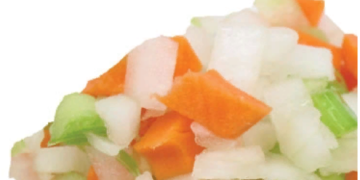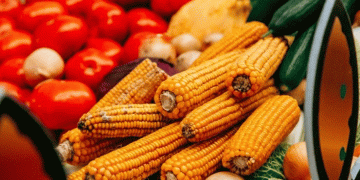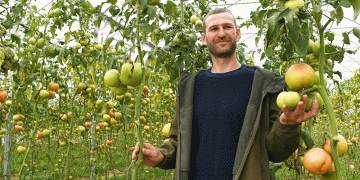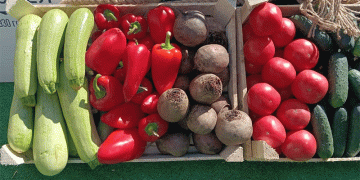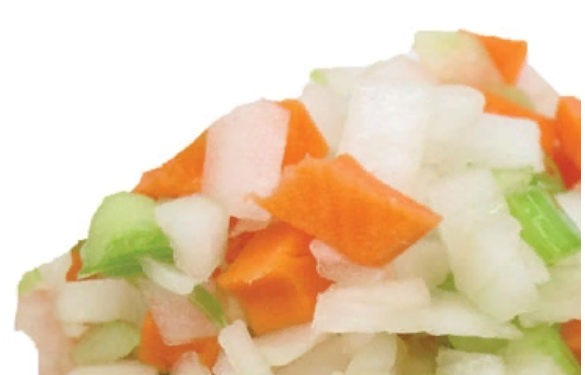It’s amazing what you can create with fresh fruit and vegetables and a knife these days.
That’s what fresh-cut processors find as they respond to demand from chefs and caterers to produce different cuts and shapes that create new visual interest for dressing up plates and buffets.
For example, Simply Fresh Fruit in Vernon, California, recently rolled out a new line of fresh-cut fruit designed for professional chefs and caterers. Its new Chef’s Choice selections include citrus wheels, pineapple half-rings, mango spears, kiwi wedges, and melon balls.
“The five new fruit cuts are unique in shape and style to go beyond the usual square cuts normally associated with fresh cut fruit,” a company press release said.
Equipment manufacturers like Urschel continue to develop new technology for creating different types of cuts. Its Model CC Slicer does everything from varying sizes of crinkle cuts to oval shreds.
But out-of-the-ordinary shapes – say, a mushroom-shaped potato – are mostly done by hand. Dan Vache, vice president of supply chain management for the United Fresh Produce Association, said major manufacturers don’t typically pursue developing equipment that would do it instead because volume doesn’t typically warrant it.
“Why they don’t do it is because … people need to do high volume in order to afford that kind of investment on cutting equipment,” he said.
But fresh-cut operations that do both automated and hand processing are set up to respond to such requests.
“We do a lot of special orders,” said Vaughn Ford, one of the owners of Ford’s Produce in Raleigh, North Carolina, which produces fresh-cut products under its Mr. Fresh! label. “We have a rule that anybody can call before noon and get it the next day, no matter what it is.
“We don’t do a lot of big runs – most are around five to 10 boxes at a time.”
Demand for unusual shapes tend to come in with chefs and caterers who want to do something different for a special event.
“Things run in trends and after a while, a lot of menus start to look alike,” Ford said. “Chefs want to have that next big thing.
“A potato is a potato no matter how you cook it … but you can make it look impressive or more inviting on the plate.”
But chefs may not have the staff to make that happen themselves.
“They don’t have the time,” Ford said. “It takes a lot of time and if they’ve got to put out a convention center meal with 1,000 plates, everybody sitting down at one time, they don’t have the labor.
“We can be an extension of their labor force.”
Ford’s last processing room manager was a professional chef who introduced several new products now standard on the Mr. Fresh! roster designed to help chefs create that “wow” factor. One of them was tourneed potatoes – a French, seven-sided elliptical cut.
“It’s very labor intensive, and expensive,” Ford said. “Right now, two pounds would be about $28.”
But chefs are willing to pay to get something different. Mr. Fresh! also offers mushroom-shaped potatoes.
“We may do potatoes eight different ways in a day,” Ford said.
With machines that peel melons, staff can then do different cuts in those as well.
“Sometimes instead of the typical bite-size chunks, people want half moons or wedges,” he said.
Ford can accommodate the quick turnaround on orders for unusual items because employees are cross trained. When he needs to, he can pull people who know how to do the cutting out of Fords’ distribution center to help meet demand.
“We’ll do just about anything,” he said. “If somebody’s willing to pay for it, we’ll do it.”
And sometimes they aren’t.
“A lot of times, people have a good idea, but once you price it out, sometimes they decide to go a different way,” Ford said.
Vance Jackson, vice president and owner at Vegetable Fresh in Chicago, operates similarly.
“We’ve gotten into all sorts of different ways to cut different items,” he said.
Some of those lately include cutting peppers, potatoes or carrots into triangles – or at Valentine’s Day, red peppers into hearts. In the latter instance, his workers used cookie cutters to cut them out.
“We’re doing a lot of carved vegetables – radish rosettes, things like that,” he said. “They’re basically side dishes for upscale restaurants, or to put on the plate as a garnish.”
The company has also been doing more with jicama, including half-moon shapes – popular in orders for school snacks, he says.
Here, too, most are done by hand.
“Anytime you do any kind of special shape you have to do it by hand or with some mechanism that is made especially for that,” Jackson says.
Tornado Fries
Lou Golato, owner of New Jersey-based Tornado Fries, has created a business around one particular unusual shape. In 2002, he started a company based on a drill with a blade, modifying an existing curly fry cutter to spiral cut a potato into thin slices while leaving the core intact. A long stick goes through the middle and the potato gets fanned out so the individual layers are separated before it goes into hot oil to be served hot in 90 seconds. Customers select from a range of seasonings.
“The potato actually fuses to the stick so you can pull off what you want without it falling apart,” Golato said.
The company started out doing fairs and trade shows, and has been operating seasonal shops in tourist areas. The next frontier is mall stores, with one recently opened in Valencia, California. Besides California, Tornado Fries is doing some business in Arizona in the winter, and in New Jersey, New York and Utah.
The company was recently featured on The Food Network’s “Unwrapped” series, which takes viewers behind the scenes to see how things are made. They’ve also been covered by National Public Radio.
“I would say the novelty of it is it kind of attracts attention,” Golato said. “and then once they taste them, they’re hooked.”
